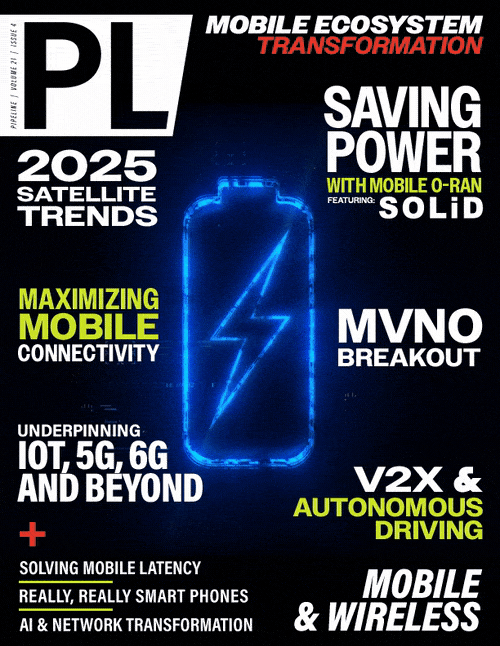Letter from the Editor - Feburary 2025

The world grows more connected with each passing second, and gone are the days when untangling balls of gnarled wires were required to do so. Invisible bits and bytes are streaming through the air all around us connecting us and our devices. Billions of us, and billions of devices. Connecting everything everywhere now relies upon pervasive and ubiquitous mobile connectivity.
The future is wireless. We’re now living in a world where you can program your coffee maker how and when to brew your coffee, and have your toaster pop up toast with a custom image, heart, or emoji burnt into it – all from your mobile device.
But for enterprises, this mobile momentum is even more powerful, and it goes well beyond those that produce smart coffee makers and toasters. Wireless connectivity is connecting everything from pacemakers, to factories, mining operations, to the Moon. In fact, Intuitive Machines just landed a rover on the moon, Nokia is testing a 4G wireless lunar network for research and colonization – and that’s happening now. But there are risks that must be mitigated associated with an interconnected everything, such as the blowback HP recently received for disabling their wireless printers when payment methods stored in their subscription-ink service expired.
But if the future is wireless, is wireline dead? We don’t think so. There is, at least for now, still a place for our good old, gnarled friends. Pervasive mobility still requires massive pipes to traverse the globe, often at the speed of light, such as fiber optics networks, which many industries are leveraging to underpin their transformation. In the near term, the path forward will continue to be comprised of mixed, heterogeneous networks to connect everything by land, sea, and beyond. Which makes things a bit more complicated.
Enabling pervasive wireless connectivity requires more than wireless network technology and fiber backhaul. It takes an ecosystem, a system of standards, and an open and distributed architecture to make it all work seamlessly, and cost effectively, indoors and out. It demands a network of optimized data centers and a boatload of supporting technologies. Content has to be hosted on the network edge to provide a superior streaming experience. Intelligent IoT gateways are needed for data analytics and to tap into the Artificial Intelligence (AI) and Generative AI (GenAI) opportunities. Collectively, the AI opportunity is changing the game, the risks, and the device.
Nevertheless, the mobile ecosystem is already creating fascinating use cases. Vehicle-to-everything (V2X) communication is enabling self-driving cars to interact with pedestrians, infrastructure, systems and other vehicles. Satellite connectivity is driving down the costs of agriculture and edge devices connected to autonomous drones are optimizing crop yields and solve global hunger. IoT deployments are making real-time climate and environmental tracking possible for proactive disaster management, and saving lives in disaster zones. We’ve certainly come a long way, but there is still much more to do as we contend with the constantly shifting mobile landscape. Which makes this edition of Pipeline so important.
In this issue of Pipeline, we explore the world of ubiquitous mobile and wireless connectivity needed to connect everything everywhere. Mobile Ecosystem Forum discusses the ecosystem transformation that is underway. Legrand addresses pervasive mobility's latency challenges by fusing telecommunications legacy systems with edge innovation. SOLiD delves into DAS and O-RAN and the potential for combining connectivity and sustainability. Quadsat showcases satellite's critical role in supporting mobile and wireless networks, and ST Engineering iDirect highlights the top 2025 satellite industry trends. Rohde & Schwarz examines how V2X technology is enabling fully autonomous cars and Lifecycle Software projects a banner year for US MVNOs. Pipeline’s Dr. Mark Cummings explores how AI is transforming devices and networks. All this, plus we bring you the telecommunications and technology new and more.
We hope you enjoy this and every issue of Pipeline.
Scott St. John
Managing Editor
Pipeline



















